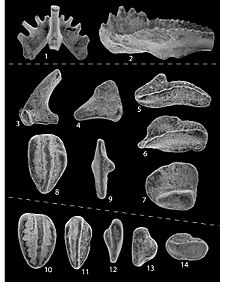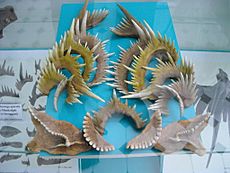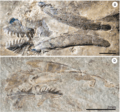Conodont facts for kids
Quick facts for kids Conodonts |
|
|---|---|
| Reconstruction of a Conodont | |
| Scientific classification | |
| Kingdom: | |
| Phylum: |
Chordata
|
| Subphylum: |
Vertebrata
|
| Synonyms | |
|
|
Conodonts were ancient, eel-like creatures that are now extinct. They lived in the oceans for millions of years, from about 495 to 199.6 million years ago. Scientists believe conodonts were among the earliest vertebrates, which are animals with backbones.
For a long time, we only knew about conodonts from their tiny, tooth-like fossils. These "teeth" are called conodont elements. The rest of their bodies were soft, so they usually didn't turn into fossils.
It wasn't until the early 1980s that scientists found complete conodont fossils. These rare fossils showed the soft body parts along with the teeth. They were discovered in a special fossil site near Edinburgh, Scotland.
What are Conodont Teeth?
The tiny "teeth" of conodonts are called conodont elements. These elements are very common in the fossil record. Scientists use them to figure out the age of rocks. This method is called biostratigraphy.
These elements are also used as ancient thermometers. This is because the color of the phosphate in the teeth changes with heat. Scientists measure these color changes using something called the conodont alteration index. This helps them find oil in rocks from the Cambrian to the Upper Triassic periods.
What Did Conodonts Look Like?
Scientists have found eleven fossil imprints of the full conodont animal. These fossils show a creature that looked a bit like an eel. It had 15, or sometimes 19, elements in its head. These elements formed a feeding tool that was different from the jaws of animals today.
Conodonts had three main shapes of teeth. These were coniform cones, ramiform bars, and pectiniform platforms. Each shape might have been used for different tasks when eating.
These creatures ranged in size from about a centimeter (less than half an inch) to a giant species called Promissum, which was 40 centimeters (about 16 inches) long. Scientists now generally agree that conodonts had large eyes. They also had fins with fin rays, special chevron-shaped muscles, and a notochord. A notochord is a flexible rod that supports the body, like an early backbone.
The entire group of Conodonts died out about 200 million years ago. This happened during a huge event called the Triassic–Jurassic extinction event.
Images for kids
See also
 In Spanish: Conodontos para niños
In Spanish: Conodontos para niños






